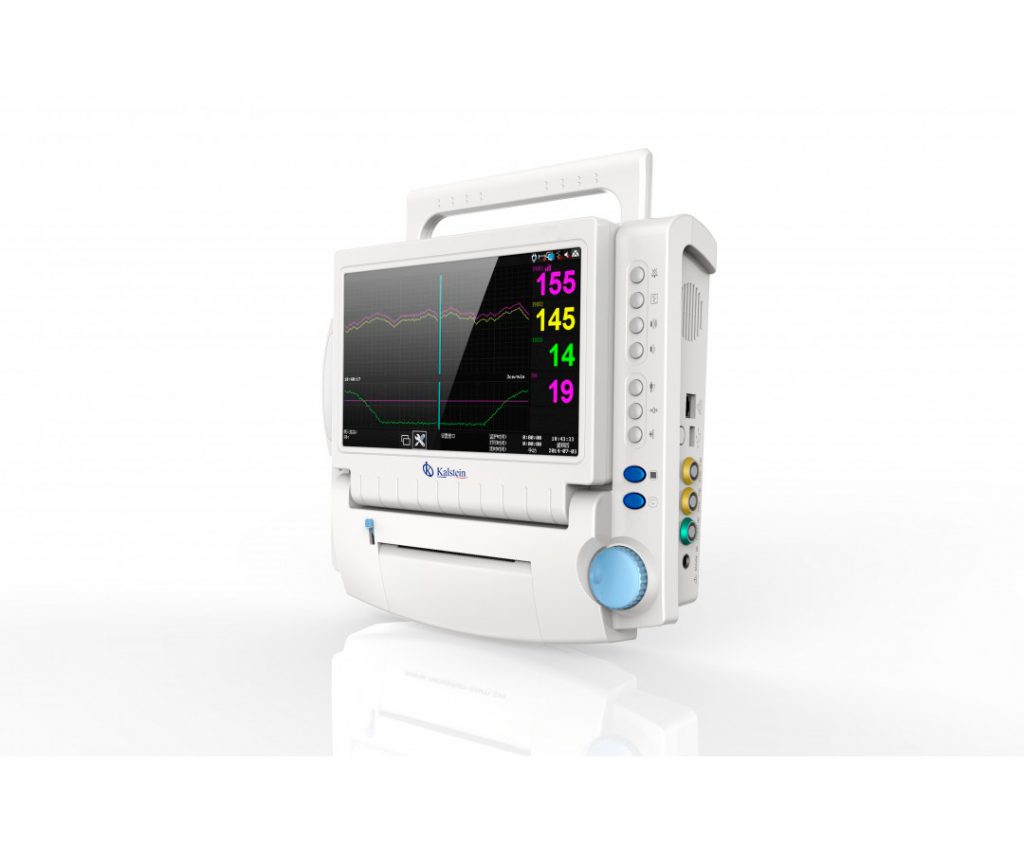A patient monitor is a medical device used to continuously detect, process and deploy the vital parameters of a patient under continuous medical surveillance, including respiratory rate, blood pressure, body temperature and pulse. This device performs a real-time recording of these parameters, reflecting their information in the form of waves and numbers for further clinical interpretation.
Patient monitors are very useful in health institutions where emergency and hospitalization services are provided. It is equipped with a series of alarms that alert health personnel when there is an adverse situation or outside the desired limits, although these can be silenced if they are trying to solve the problem that has generated them.
Types of patient monitors
Fixed Patient Monitors
They are those located in the head of the patient and are attached to the wall by a special support designed for this purpose or, where appropriate, to the anesthesia machine. These in turn can be classified into:
- Patient Monitor for Anesthesia: During anesthesia, equipment specially designed for this process should be used, as these equipment focus on monitoring systems that may suffer some compromise or damage from lack of oxygen or circulation, such as brain, kidneys and heart. These parameters include ECG, SpO2, PI, PNI, cardiac output, CO2, O2, temperature, anesthetic gases, neuromuscular transmission, EEG and transcranial Doppler.
- Adult/Pediatric Patient Monitors: This type of monitors are used in critical care areas, commonly the specific application by type of patient is achieved through the consumables that the team uses (electrodes, bracelets and sensors). It is recommended to always have consumables of all sizes in order to make these monitors more flexible and that this way they can be used in adult and pediatric patients.
- Neonatal-type patient monitoring: Premature babies and newborns have their own characteristics in terms of care and handling, since they cannot be considered as small adults, because they have a unique physiological entity. So many of the parameters determined by patient monitors need to be measured differently. Where respiration and temperature control are of high interest and care. The parameters measured are ECG, SpO2, PI, PNI, respiration, temperature and intracranial pressure.
Transportation Patient Monitors
- In-hospital patient monitors: They are used to monitor a patient moving from one area to another within the same health center. They monitor ECG, SpO2, PNI. They have an integrated register and battery with a duration of at least 2 hours.
- In-hospital patient monitors: They’re used to transport the patient from one health center to another. They determine parameters such as ECG, SpO2, PNI and have a connection to connect to the ambulance.
How does a vital sign monitor work?
A vital signs monitor is responsible for collecting, displaying and storing all vital signs of the patient. It works differently for each vital sign, for example, to determine heart rate (ECG), collects electrical activity of the heart by electrodes and amplifies it. To measure the respiratory rate (RESP) collects and amplifies the respiratory movements of the chest. To determine the amount of oxygen the patient (SpO2) does through his pulse.
The patient monitor uses a thermometer to display patient temperature (TEMP) at all times. Non-invasive blood pressure (NIBP) is obtained using an electronic sphygmomanometer, whose bracelet is located in the patient’s arm. All these parameters are analyzed separately in the vital signs monitor. In the event that some of these parameters are below or above normal for the patient’s age, or any other adverse activity occurs, an alarm is triggered to alert health personnel.
What do we offer you in Kalstein?
Kalstein is a company MANUFACTURER of medical and laboratory equipment of the highest quality and the best technology at the best PRICES of the market, so you can make your PURCHASE with us confidently, knowing that you have the service and advice of a company specialized in the field and committed to innovation. This time we present you our Patient Monitor YR02177. This new patient monitor has the following features:
- 8.4-inch touch screen; Embedded handle; Capable of using the module; 1.6 kg weight; 5 hours of battery life; Design without fan.
- Built-in handle weighing 1.6 kg, easy to carry;
- Capable of using the module, the available EtCO2 and anesthetic depth monitoring modules;
- 5 hours of battery life, covers the requirement for patient transfer;
- Compatible vehicle power supply;
- The fan-less design ensures low noise;
- Multiple interfaces for different departments.
For more information we invite you to take a look at HERE

